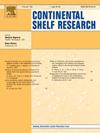Effect of coastal front and water masses on the spatial pattern of sedimentary biomarkers in the East China Sea
IF 2.2
3区 地球科学
Q2 OCEANOGRAPHY
引用次数: 0
Abstract
Coastal fronts are important physical boundary between coastal and offshore water masses in the ocean. The secondary circulation generated by fronts can greatly impact matter transport across fronts, leading to the different sedimentary environments between water masses. To understand the combined effects of fronts and water masses on the sedimentary environment in the East China Sea, we studied the spatial patterns of grain size, organic matter and biomarkers in surface sediments crossing the Min-Zhe Coastal Front (MZCF), combined with observational data in the upper ocean. The results showed that the front and water masses jointly determined the spatial pattern of sedimentary environments in the East China Sea. Marine organic matter dominated in the mud area, with higher concentrations at the frontal region. Terrestrial organic matter exhibited a decreasing trend from nearshore to offshore, particularly at the frontal shore-side, indicating the barrier effect of the front on coastal matter transport. The mean ratio between brassicasterol and dinosterol (B/D) in the sediments of MZCF and East China Sea coastal water mass (ECSCoW) was 2.8, which was lower than the B/D (3.8) in the sediments of East China Sea shelf water mass (ECSSW) and indicated that dinoflagellates are confined at the frontal shore-side water mass. The spatial patterns of diatom and dinoflagellate pigments in the water column were consistent with the biomarker patterns in the sediments and corresponded to the different habitats (e.g., nutrients, salinity) generated by the ECSCoW, ECSSW, and MZCF. The study explained the combined effects of front and water masses on sedimentary environments in the East China Sea and suggested to use fronts as boundary to distinguish water mass environments in paleo-oceanographic reconstruction.
海岸带和水团对东海沉积生物标志物空间格局的影响
海岸锋是海洋中沿海和近海水团之间的重要物理边界。锋面产生的二次环流对锋面间的物质输运有很大影响,导致水团间沉积环境的差异。为了解锋面和水团对东海沉积环境的综合影响,结合上层海洋观测资料,研究了闽浙海带表层沉积物粒度、有机质和生物标志物的空间格局。结果表明,锋面和水团共同决定了东海沉积环境的空间格局。泥岩区以海相有机质为主,前缘区浓度较高。陆相有机质呈现由近岸向近海递减的趋势,尤以锋面滨侧为明显,说明锋面对海岸物质运移具有阻隔作用。MZCF和东海沿岸水团(ECSCoW)沉积物中油菜甾醇和甲酰甾醇的平均比值(B/D)为2.8,低于东海陆架水团(ECSSW)沉积物中的B/D(3.8),表明甲酰鞭毛虫被限制在锋岸水团。水柱中硅藻和鞭毛藻色素的空间格局与沉积物中的生物标志物格局一致,并对应于ECSCoW、ECSSW和MZCF所产生的不同生境(如养分、盐度)。研究解释了锋面和水团对东海沉积环境的综合影响,建议在古海洋学重建中以锋面作为区分水团环境的边界。
本文章由计算机程序翻译,如有差异,请以英文原文为准。
求助全文
约1分钟内获得全文
求助全文
来源期刊

Continental Shelf Research
地学-海洋学
CiteScore
4.30
自引率
4.30%
发文量
136
审稿时长
6.1 months
期刊介绍:
Continental Shelf Research publishes articles dealing with the biological, chemical, geological and physical oceanography of the shallow marine environment, from coastal and estuarine waters out to the shelf break. The continental shelf is a critical environment within the land-ocean continuum, and many processes, functions and problems in the continental shelf are driven by terrestrial inputs transported through the rivers and estuaries to the coastal and continental shelf areas. Manuscripts that deal with these topics must make a clear link to the continental shelf. Examples of research areas include:
Physical sedimentology and geomorphology
Geochemistry of the coastal ocean (inorganic and organic)
Marine environment and anthropogenic effects
Interaction of physical dynamics with natural and manmade shoreline features
Benthic, phytoplankton and zooplankton ecology
Coastal water and sediment quality, and ecosystem health
Benthic-pelagic coupling (physical and biogeochemical)
Interactions between physical dynamics (waves, currents, mixing, etc.) and biogeochemical cycles
Estuarine, coastal and shelf sea modelling and process studies.
 求助内容:
求助内容: 应助结果提醒方式:
应助结果提醒方式:


